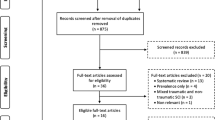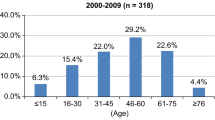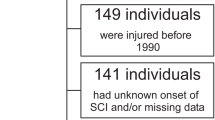Abstract
Introduction
Cultural and socioeconomic factors influence the risk of sustaining a Traumatic Spinal Cord Injury (TSCI). The standard of management and rehabilitation available to TSCI patients differs greatly between high-income and low-income countries.
Case presentation
We report a 17-year-old male bird hunter, with no prior medical history, presenting with paraplegia and sensory loss from the xiphoid process down after being struck by an arrow in the left lateral side of the neck.
Discussion
Penetrating neck injuries are potentially life threatening because of the complex arrangement of vital structures in the neck. Management of spinal cord trauma resulting from such injuries in low-resource settings is challenging.
Similar content being viewed by others
Login or create a free account to read this content
Gain free access to this article, as well as selected content from this journal and more on nature.com
or
References
World Health Organisation. International perspectives on spinal cord injury. Geneva, Switzerland: WHO Press; 2013.
Reardon JM, Andrade L, Hetz J, Kiwango G, Teu A, Pesambili M, et al. The epidemiology and hotspots of road traffic injuries in Moshi, Tanzania: an observational study. Injury. 2017;48:1363–70.
Fisk N, Hulme-Moir I, Scrimgeour EM, Schlabach WE. Traumatic paraplegia in northern Tanzania. Trop Doct. 1985;15:23–26.
Rashid SM, Jusabani MA, Mandari FN, Dekker MC. The characteristics of traumatic spinal cord injuries at a referral hospital in Northern Tanzania. Spinal Cord Ser Cases. 2017;3:17021.
Moshi H, Sundelin G, Sahlen KG, Sörlin A. Traumatic spinal cord injury in the north-east Tanzania describing incidence, etiology and clinical outcomes retrospectively. Glob Health Action. 2017;10:1355604.
Yatsuka H. Reconsidering the “indigenous peoples” in the African context from the perspective of current livelihood and its historical changes: the case of the Sandawe and the Hadza in Tanzania. Afr Stud Monogr. 2015;36:27–47.
Kirshblum SC, Waring W, Biering-Sorensen F, Burns SP, Johansen M, Schmidt-Read M, et al. Reference for the 2011 revision of the international standards for neurological classification of spinal cord injury. J Spinal Cord Med. 2011;1:547–54.
Cripps RA, Lee BB, Wing P, Weerts E, Mackay J, Brown D. A global map for traumatic spinal cord injury epidemiology: towards a living data repository for injury prevention. Spinal Cord. 2011;49:493–501.
Otom AS, Doughan AM, Kawar JS, Hattar EZ. Traumatic spinal cord injuries in Jordan – an epidemiological study. Spinal Cord. 1997;35:253–5.
Witt A, Kumru H, Opisso E, Vidal J. Traumatic spinal cord injury due to human tower accident in Catolonia. Spinal Cord Ser Cases. 2018;4:108.
Macharia WM, Njeru EK, Muli-Musiime F, Nantulya V. Severe road traffic injuries in Kenya, quality of care and access. Afr Health Sci. 2009;9:118–24.
London JA, Mock CN, Quansah RE, Abantanga FA, Jurkovich GJ. Priorities for improving hospital-based trauma care in an African city. J Trauma. 2001;51:747–53.
Ahidjo KA, Olayinka SA, Ayokunle O, Mustapha AF, Sulaiman GA, Gbolahan AT. Prehospital transport of patients with spinal cord injury in Nigeria. J Spinal Cord Med. 2011;34:308–11.
Netter F. Atlas of human anatomy. 6th edn. UK: Elsevier; 2014.
Hung DZ, Hung YH. Anticholinergics syndrome related to plants and herbs. Toxinology. 2015;2:569–86.
Stanifer JW, Patel UD, Karia F, Thielman N, Maro V, Shimbi D, et al. The determinants of traditional medicine use in northern Tanzania: a mixed-methods study. PLoS One. 2015;10:e0122638.
Dekker MCJ, Urasa SJ, Howlett WP. Neurological letter from Kilimanjaro. Pr Neurrol. 2017;5:412–6.
Feikin DR, Nguyen LM, Adazu K, Ombok M, Audi A, Slutsker L, et al. The impact of distance of residence from a peripheral health facility on pediatric health utilization in rural western Kenya. Trop Med Int Health. 2009;14:54–61.
Bright T, Wallace S, Kuper H. A systematic review of access to rehabilitation for people with disabilities in low- and middle- income countries. Int J Environ Res Public Health. 2018;15:2165.
Author information
Authors and Affiliations
Corresponding author
Ethics declarations
Conflict of interest
The authors declare that they have no conflict of interest.
Ethical approval
The case study was approved of by the Medical Ethics Committee of KCMC, Moshi, United Republic of Tanzania in the framework of a study on neurological disorders.
Informed consent
Informed consent was obtained from the patient and their guardian.
Additional information
Publisher’s note: Springer Nature remains neutral with regard to jurisdictional claims in published maps and institutional affiliations.
Rights and permissions
About this article
Cite this article
van Adrichem, D.C., Ratering, M.R.H.A., Rashid, S.M. et al. Penetrating spinal cord injury causing paraplegia in a bird hunter in rural Tanzania. Spinal Cord Ser Cases 5, 49 (2019). https://doi.org/10.1038/s41394-019-0195-7
Received:
Revised:
Accepted:
Published:
DOI: https://doi.org/10.1038/s41394-019-0195-7
This article is cited by
-
Ox cart accidents as a cause of spinal cord injury in Tanzania
Spinal Cord Series and Cases (2020)
-
Prehospital care of trauma patients in Tanzania: medical knowledge assessment and proposal for safe transportation of neurotrauma patients
Spinal Cord Series and Cases (2020)



